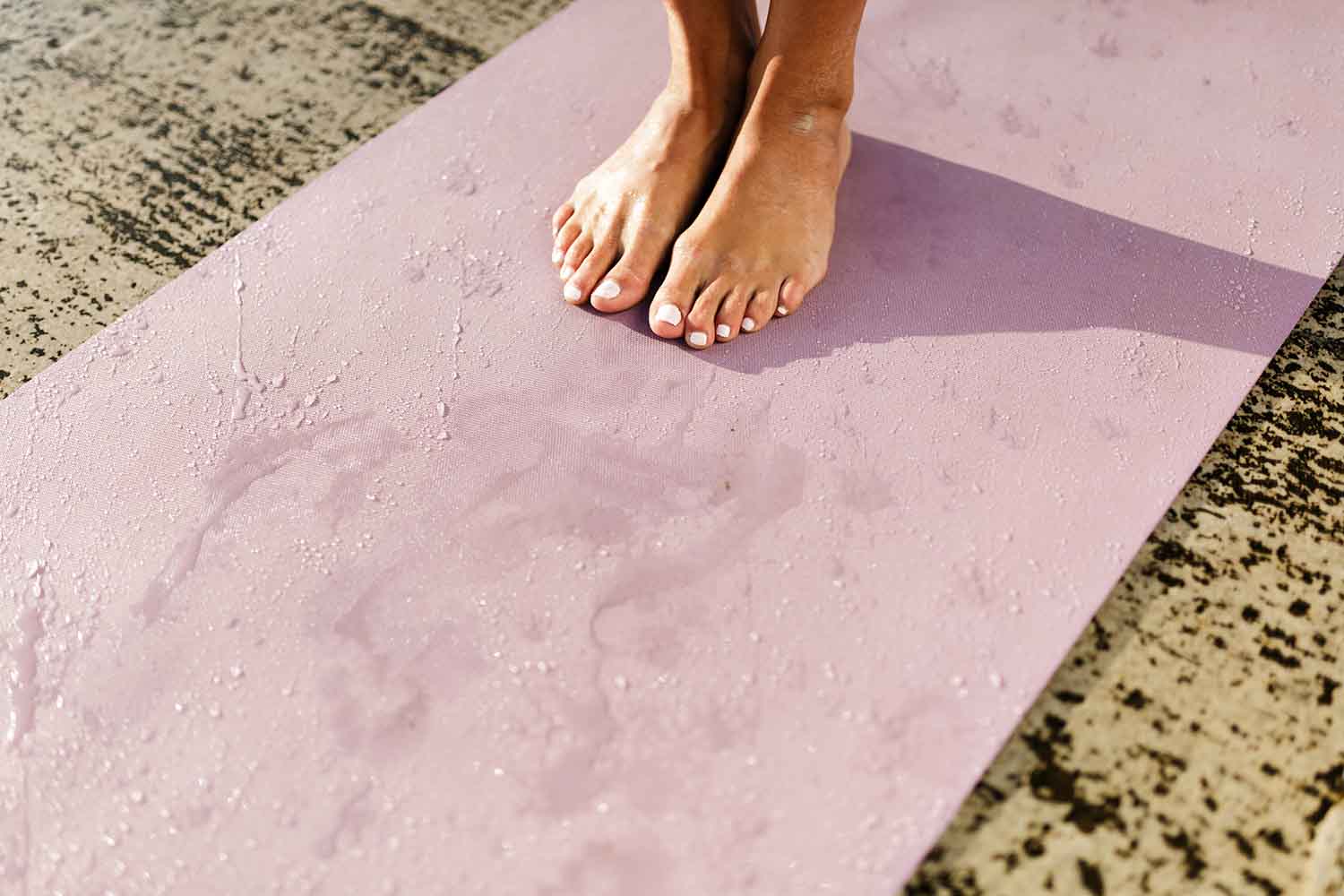Why Is My Yoga Mat Slippery?
A slippery yoga mat can significantly disrupt your yoga practice, leading to discomfort and loss of balance. This is common with new yoga mats, which often have a slick coating from the manufacturing process. This layer is designed to protect the mat during shipping and storage but makes it harder to grip during practice.
Sweat can also contribute to making your yoga mat feel slippery. As moisture builds up during your practice, the mat’s surface can lose traction, especially if the material is prone to slickness, like PVC. Natural materials such as cork or rubber offer much better grip in comparison, making them ideal for those who sweat heavily during sessions.
Dirt, body oils, and lotions also accumulate on your yoga mat over time, further reducing grip. To avoid having a slippery mat, not only should you break it in, but regular cleaning is essential to maintain its surface and ensure a safe, stable practice.
Steps to Make Yoga Mat Less Slippery
Break In Your Yoga Mat
Breaking in your yoga mat is a critical first step to ensure it’s not too slippery during your practice. New mats often have a factory-applied coating that feels slick, but this effect fades as the surface is broken in with regular use.
Consistent use will wear down the slick layer and improve grip over time. To speed up this process, scrub the mat with a mixture of water and mild soap or vinegar. This helps remove the residue, making the surface more grippy. Another helpful tip is to practice dynamic movements like Vinyasa, as these generate friction that helps break in the yoga mat faster. After each session, be sure to dry the mat completely to prevent lingering moisture, which can make the yoga mat slippery during the next use.
Try a Towel for Extra Traction on a Slippery Mat
If your yoga mat continues to feel slippery, using a towel can offer extra traction. In sweaty practices, a microfiber or yoga towel can absorb the moisture, helping to prevent slipping. Spread the towel over the mat, especially in areas where your hands and feet frequently land, such as during Downward Dog or Warrior poses.
Some towels come with anti-slip properties like silicone grips to ensure they stay in place. These work particularly well in hot yoga or high-sweat environments. By using a towel, you’ll find it easier to hold poses and prevent accidents caused by slipping on a slippery yoga mat.
Use a Yoga Mat Spray or Grip Enhancer
Another method to make your yoga mat less slippery is by using a yoga mat spray or grip enhancer. These products are designed to make yoga mats more grippy by breaking down any slick surface on the mat. A homemade spray using natural ingredients like water, vinegar, and essential oils can both clean and improve traction.
Grip enhancers, available as sprays or balms, increase friction between your hands and the mat, providing more stability during poses. Simply apply these products before or during your practice for better results. They’re especially useful during sweaty sessions where grip is crucial.
Wash and Clean Your Yoga Mat Regularly
Regular cleaning of your yoga mat is one of the most effective ways to ensure your yoga mat does not become slippery. Sweat, dirt, and oils can build up on the surface, making the yoga mat hard to grip over time. Clean your mat after every session, especially if you sweat heavily, using water and mild soap or a natural spray solution with vinegar.
After wiping down the mat, let it air dry completely before rolling it up. This will help maintain its grip and ensure that moisture does not make the mat slippery. For deeper cleaning, soak the yoga mat in a tub with water and mild detergent, scrub gently, and rinse thoroughly. Avoid using harsh chemicals that could damage the mat’s material over time.
How to Prevent Slippery Yoga Mats in the Future
Choose a Non-Slip Yoga Mat
To prevent slipperiness long-term, investing in a non-slip yoga mat is key. Materials like natural rubber, cork, or textured polyurethane are designed to offer better traction than standard PVC mats. These materials help ensure your mat is not too slippery during practice, even in high-moisture conditions.
When selecting a yoga mat, look for features such as textured surfaces or moisture-wicking properties, which will prevent sweat from pooling and making the mat slick. Cork mats, for example, increase their grip when wet, while rubber mats are naturally tacky and provide consistent traction throughout practice.
Choosing a non-slip yoga mat can save you from constantly needing to use towels or grip enhancers. It’s a smart long-term investment for a safer and more reliable practice. Popular brands offer mats with anti-slip features, specifically designed for hot or intense yoga sessions.

